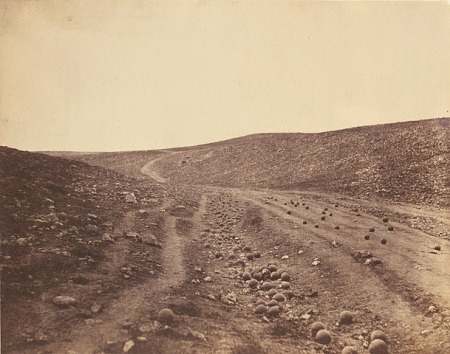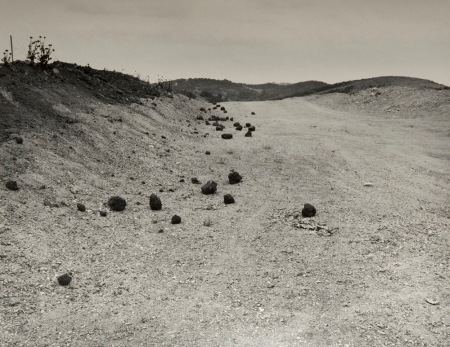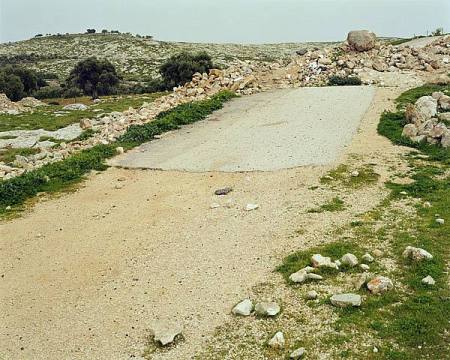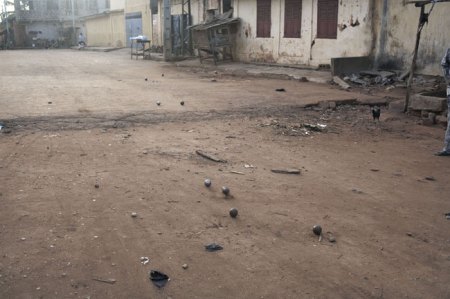
Roger Fenton, Valley of the Shadow of Death, 1855; Courtesy Getty Museum
Often cited as the first war photographer, Roger Fenton was dispatched to photograph the Crimean War in 1855 at the behest of publisher Thomas Agnew. Documenting a widely unpopular military campaign, Fenton avoided turning his lens upon the destruction produced by the theater of war. The slow exposures and photographic technology of the time were prohibitive in freezing any motion and actions, making depiction of actual scenes of battle impossible. But whether by editorial bias or his general Victorian sensibilities, unlike his counterparts in the American Civil War, Fenton declined to make images of the dead and wounded. The resulting exhibition of photographs from over 300 wet plate negatives primarily depicted portraits of soldiers in camp, as well as the barren plains upon which they pitched their tents.
Fenton’s most famous photograph, Valley of the Shadow of Death, of which there are two exposures, was taken in the Crimea. A Martian landscape recedes before the camera, the packed dirt road winding to the distance, pocked by scattered cannonballs lying in the ruts and gutters. No tree breaks the horizon, no solitary figure wanders the road. For a photograph of a war zone it is remarkably silent; I imagine not the sound of cannon fire, but perhaps merely the low whistle of the wind. It is an image of a landscape devastated, admitting no life. Fenton adopted the soldiers’ name for the valley, evocative in its Biblical associations. The 21st century viewer might call to mind Cormac McCarthy’s apocalyptic settings in the American west.
This image has captivated subsequent historians and photographers alike (witness Errol Morris’s recent investigations into Fenton’s “stagecraft” of the photograph), so it is worth considering what about the image is noteworthy. As suggested earlier, Fenton’s work does not easily fit into a modern conception of war photography, marked as that genre is by notions of the event and action. Instead it is truly a landscape photograph, conforming to certain conventions, and suggestive of an archetypal quality even in its specific elements. It is exceedingly spare and elegantly composed, seeming to admit no extraneous details in order to communicate an idea of the landscape through a great economy of means. This restraint, I believe, is what makes the image so iconic. Thinking reductively, the contents of the picture can be cataloged thus: earth, horizon, road, cannonballs. Its very title speaks of death, and of an epic suffering, but also of divine faith (23rd Psalm).

Joe Deal, Road Cut (Homage to Roger Fenton) Diamond Bar, California, 1984; Courtesy Robert Mann Gallery, New York
Spare and understated, formally precise by with a minimum of inflection, and certainly depicting a “Man-Altered Landscape,” it comes as no surprise that Fenton’s picture was echoed over a hundred years later by one of the principal artists associated with the New Topographics style. Working on his surveys of suburban development in Southern California, Joe Deal made Road Cut (Homage to Roger Fenton) Diamond Bar, California, 1984.
Deal’s homage shares many of the same elements as Valley of the Shadow of Death, so it is illuminating to see where they differ, and how Deal’s citation of photographic history suggests the stakes of his own project. As with Fenton’s photograph, Deal’s relies on information provided by the title to endow the image with meaning, both in the invocation of Fenton and in the naming of the “road cut.” Deal replaces the cannonballs of the 19th century with the moist dirt clods of suburban development—his is not a landscape that bares witness to violence, it is a landscape under attack—the “cut” of the title a scar across a hillside, marked by human disturbance. In Fenton’s picture there are artifacts of violence whereas in Deal’s there are traces.
25 years after Deal plodded the subdivisions around Los Angeles, the political contexts of the work of Sophie Ristelhueber and Guy Tillim are considerably different, but they also make use of the iconic status of Fenton’s photograph in order to buttress their own notions of landscape and war.

Sophie Ristelhueber, WB #48, 2005; Courtesy Blancpain Art Contemporain, Geneva
Ristelhueber’s series WB depicts roadblocks in the West Bank. A number of photographs in the series resemble Valley of the Shadow of Death, but WB #48, 2005 most explicitly echoes the composition of Fenton’s picture. Like Deal’s photograph, cannonballs have been replaced by earthen matter, here rocks and boulders lining the road and finally piled into a barrier. If Deal’s image depicted a landscape disrupted by human development, here human action has folded the landscape back upon itself, negating the earlier action that created the road. But if it is a return it is hardly an innocent one. One hardly needs the presence of cannonballs to understand (again aided by the knowledge that this is the West Bank) that this is a contested landscape. In this sense we can also consider Ristelhueber’s well-known photographs of scarred human flesh to be landscape pictures.

Guy Tillim, Game of petanque, Porto Novo, Benin, 2007; Courtesy Michael Stevenson Gallery, Cape Town
Guy Tillim’s photograph Game of petanque, Porto Novo, Benin, 2007 comes from the series Avenue Patrice Lumumba. With this body of work Tillim photographed across Sub-Saharan Africa, where many avenues, streets and city squares are named after the assassinated leader who remains an icon of post-colonial nationalism. In many ways the citation and relationship of this image is an inversion of the negative connotations at play in the previous photographs. It shares many of the pictorial conventions again, but with significant reversals. Notably the landscape is urban, rather than suburban or rural, and depicts a person, barely encroaching on the edge of the frame to let us know this is a scene that is unquestionably populated and existing in a specific moment. Also of note is the motion blur of one of the petanque balls; whereas the photographs by Fenton and Ristelhueber suggest stasis, crucially this is a landscape as yet in motion, dynamic and unfolding in its potential. (Deal’s landscape seems a fresh wound, not entirely realized, and speaking of further disruptions to come.) While the cannons, dirt clods and roadblocks are explicit in their forms of violence, the petanque balls are much more ambiguous. On the one hand they evoke play and forms of conviviality and leisure. But also lurking is the subtext of colonialism, the game itself a legacy of French rule in Benin. For all of the promise and subsequent strife of post-colonial African politcs, this is a landscape still very much open to determination.
Each of the photographs by Deal, Ristelhueber and Tillim builds upon the citational politics of Fenton’s Valley of the Shadow of Death. But taken as a whole, they each propose politicized views of landscape through their pictorial means. At the heart of these images is the road, a social space constituted by bodies in transit. Formally it introduces depth, and according to a classical pictorial conception of landscape allows the viewer to follow a path into the picture, and ultimately into the world created by the camera. In Fenton’s version (and according to his narration of the day) the road was too dangerous to admit passage. Deal’s subdivision speaks of the inevitability of more roads, more houses, and more development, and eventually those families who will make their homes there. Ristelhueber’s landscape has already foreclosed admission; it denies movement to marked bodies. Finally, Tillim shows a public space still carrying the legacy of its past, but with a potential for advancement into the future, a battlefield morphed into a public space of convergence. Each picture is therefore a question of passage and the politics of movement within a landscape: at the most basic, who can go where? It is a small leap to then consider border disputes as well as notions of property and sovereignty, urban planning and ecology, as being related to notions of landscape. In introducing questions of violence and access into the discussion of landscape, we can begin to examine the political potential of the genre.
Tags: Guy Tillim, Joe Deal, New Topographics, Photography, Roger Fenton, Sophie Ristelhueber, Valley of the Shadow of Death
November 13, 2009 at 9:13 PM |
Fantastic article. I know I am late on this. To end on Tillim, a photographer I believe is one of the crafts’ best thinkers was a treat.
November 27, 2009 at 11:24 PM |
Man casts a shadow when he stands in the light.
Death casts a shadow when standing in silence.
Seek not the shadow, for it is an illusion. Seek instead the light and the silence because it is the reality of death and man.